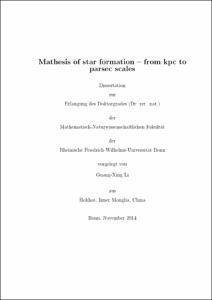Mathesis of star formation – from kpc to parsec scales

Mathesis of star formation – from kpc to parsec scales

| dc.contributor.advisor | Menten, Karl M. | |
| dc.contributor.author | Li, Guang-Xing | |
| dc.date.accessioned | 2020-04-20T18:27:18Z | |
| dc.date.available | 2020-04-20T18:27:18Z | |
| dc.date.issued | 16.06.2015 | |
| dc.identifier.uri | https://hdl.handle.net/20.500.11811/6383 | |
| dc.description.abstract | In this thesis I present a series of studies aiming to understand the formation of stars from gas in the Milky Way. Generally speaking, I will progress from larger to smaller scales. The kilo-parsec scale (1000 parsec ~ 10^21 cm) is the scale at which dynamics of the molecular clouds is coupled to dynamics of the Milky Way disk. Here we present an observational study of molecular gas at 49.5 deg Protostellar outflow ~ 1 pc is a prominent process accompanying the formation of stars. In this work, we theoretically investigate the possibility that the outflow results from interaction between the wind and the ambient gas in the form of turbulent entrainment. In our model, the ram-pressure of the wind balances the turbulent ram-pressure of the ambient gas, and the outflow consists of the ambient gas entrained by the wind. We demonstrate that the outflow phenomena can be naturally generated through this process, and discuss the potential usage of outflows as a probes of the dynamical state of the turbulent molecular gas. | |
| dc.language.iso | eng | |
| dc.rights | In Copyright | |
| dc.rights.uri | http://rightsstatements.org/vocab/InC/1.0/ | |
| dc.subject.ddc | 530 Physik | |
| dc.title | Mathesis of star formation – from kpc to parsec scales | |
| dc.type | Dissertation oder Habilitation | |
| dc.publisher.name | Universitäts- und Landesbibliothek Bonn | |
| dc.publisher.location | Bonn | |
| dc.rights.accessRights | openAccess | |
| dc.identifier.urn | https://nbn-resolving.org/urn:nbn:de:hbz:5n-38178 | |
| ulbbn.pubtype | Erstveröffentlichung | |
| ulbbnediss.affiliation.name | Rheinische Friedrich-Wilhelms-Universität Bonn | |
| ulbbnediss.affiliation.location | Bonn | |
| ulbbnediss.thesis.level | Dissertation | |
| ulbbnediss.dissID | 3817 | |
| ulbbnediss.date.accepted | 20.10.2014 | |
| ulbbnediss.fakultaet | Mathematisch-Naturwissenschaftliche Fakultät | |
| dc.contributor.coReferee | Kroupa, Pavel |
Dateien zu dieser Ressource
Das Dokument erscheint in:
-
E-Dissertationen (4104)




